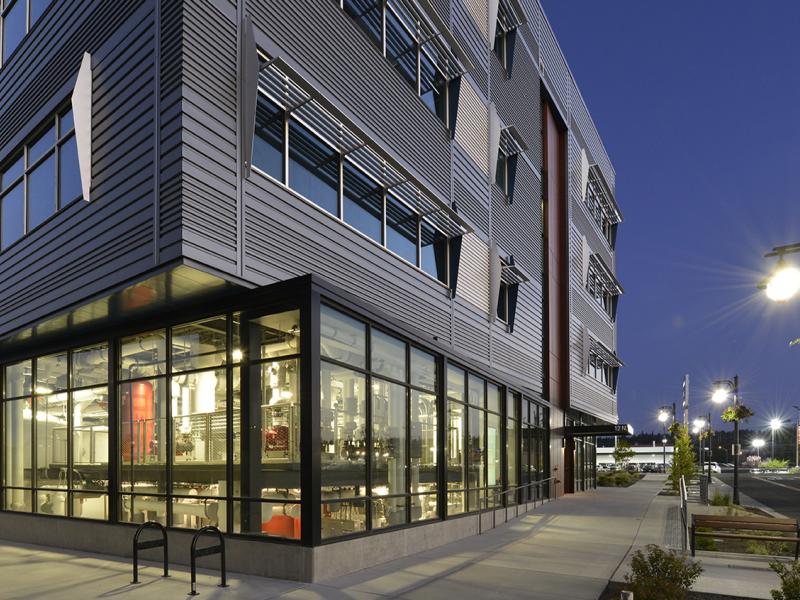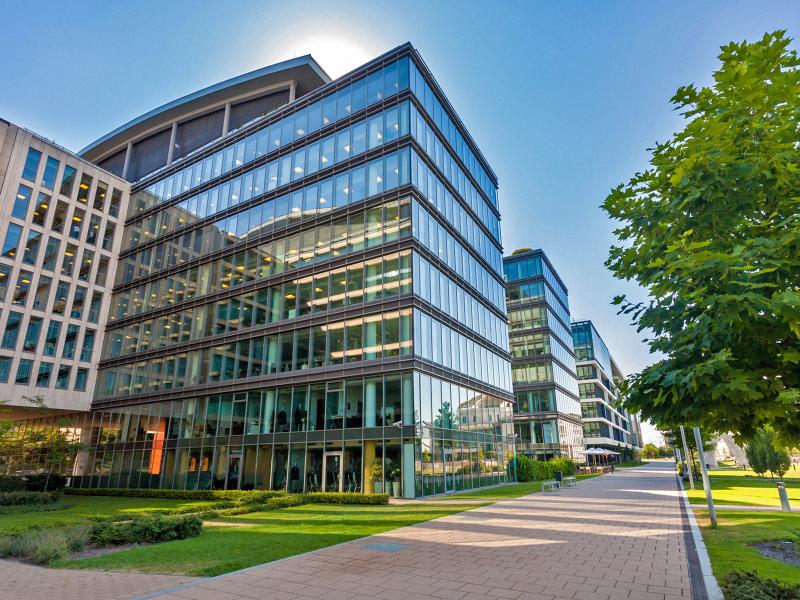
Expertise for
Efficient Buildings
Expertise for
Efficient Buildings
Pacific Northwest National Laboratory (PNNL) highlights its expertise in advanced lighting and building controls, building energy codes, and technology integration
At PNNL, we work with the Department of Energy’s Building Technologies Office to improve America's building stock and achieve key national goals. Our expertise, capabilities, and track record are best in class. We successfully transform energy management in residential and commercial buildings, which saves energy, mitigates climate change, drives a national clean energy economy, and addresses issues of energy inequity.
PNNL: expertise in efficiency
More than 200 award-winning staff at PNNL are committed to making homes and buildings more energy-efficient while concurrently maintaining comfort for occupants. In the buildings domain, PNNL has received
- seven Federal Laboratory Consortium awards
- one R&D 100 Award
- numerous professional society awards, fellow designations, and other recognition for individual staff accomplishments.
Our buildings-related research and development resources are directed in areas such as advanced lighting, building controls, building energy codes, and technology integration. We’re focused on making sure our technologies not only are deployed to meet national energy needs but benefit all communities and sectors.
A Q&A with a few of our experts
Four staff members recently discussed their work, technology deployments, energy equity, and PNNL capabilities.

Bob Davis
Advanced Lighting
Chief Lighting Research Engineer
Electricity Infrastructure and Buildings Division
Biography
I love my job because…
I get to work with a bunch of super-smart, super-talented, super-nice people who are passionate about doing excellent work that makes an impact. Beyond our own team, our extensive collaborations with architects, designers, product manufacturers, and facility managers across the United States have allowed me to meet people from wildly diverse backgrounds who are excited to work together toward the goal of better buildings.
What is your proudest technology deployment and why?
I often work with early adopters of new energy-efficient lighting technology, and we have recently been privileged to collaborate on deployment projects where the non-energy benefits were considered at least as important as the energy benefits. Examples include lighting that empowers teachers to better manage the classroom environment for special needs students, lighting in senior care centers that supports healthier sleep cycles and may reduce the need for some medications, and patient room lighting that can help reduce stress and promote healing.
How does your work support energy equity?
Too often, the “buzz” around the deployment of technology lighting solutions focuses on new award-winning buildings that attract a lot of media attention. Unfortunately, these buildings often cater to advantaged populations, while other people must reside in older buildings with out-of-date technology. As one example of how we hope to change this, we recently completed a project focused on senior care centers in the upper Midwest that investigated how newer lighting solutions could be implemented on a cost-effective basis in older facilities. We’d like to facilitate solutions that provide everyone with access to the best possible lighting solutions.
What sets PNNL apart from other organizations working in advanced lighting?
We do laboratory-based research that explores questions related to traditional lighting science, such as color rendering, glare, flicker, visibility, and visual perception. We conduct field evaluations of how new lighting technologies are being implemented in buildings of all types, as well as in exterior settings, and we explore not only energy savings but also occupant impacts. We study connected lighting systems and the emerging role of data and how both fit into intelligent buildings and the “smart grid.” We also investigate how the increasing complexity of data-driven systems affects contractor installation and commissioning. We help develop new simulation tools that can lead to better integration of daylighting and electric lighting in future buildings. And we respond to new questions as the world keeps changing around us—the best example is our expanding involvement with germicidal ultraviolet lighting for disinfection purposes. Other organizations typically do good work in one or two of these areas, but our breadth of scope sets us apart.

Supriya Goel
Building Energy Codes
Senior Research Engineer
Electricity Infrastructure and Buildings Division
Biography
I love my job because...
My work is highly impactful and plays a key role in the transition to a clean energy future. My team is well recognized as a thought leader in the field of building energy codes, and our work influences national-, state-, and city-level policies.
What is your proudest technology deployment and why?
I am proud of the work we have done in the development and deployment of a system performance approach called Total System Performance Ratio. This provides a new metric for evaluating heating, ventilation, and air-conditioning system performance and is now making its way into national and state energy codes. The metric supports electrification and decarbonization goals and uses a simplified modeling approach for performance-based analysis.
How does your work support energy equity?
Building energy codes help make sure buildings have comfortable, healthy, and safe indoor environments. While more stringent energy code requirements have associated costs, PNNL performs a detailed benefits analysis on code requirements and proposes revisions to the code that are cost-effective.
What sets PNNL apart from other organizations working in building energy codes?
PNNL’s expertise and extensive experience in development of building energy codes is unparalleled. Some of the code compliance pathways developed and championed by PNNL are now widely used nationally and internationally.

Srinivas Katipamula
Advanced Building Controls
Staff Scientist
Electricity Infrastructure and Buildings Division
Biography
I love my job because...
I was always passionate about and interested in energy conservation and improving energy efficiency of the built environment. In my job at PNNL, I get to do what I love with a group of amazing co-workers to make a difference. We are at the forefront of developing solutions to mitigate climate change, which is an existential threat to our society. If we don't reduce greenhouse gas emissions significantly, our children and grandchildren will have a hard time living on this wonderful planet Earth.
What is your proudest technology deployment and why?
I made many valuable contributions in the field of energy efficiency, but one that I am most proud of is leading the development of software that is fully automated and assures not only that a building’s operation is continuously monitored, but that operational issues affecting efficiency are corrected. Partly inspired by our approach, cities like Seattle and Philadelphia have adopted "tune-up" mandates as part of their climate change mitigation plans. I hope more cities and states will follow through.
How does your work support energy equity?
Fortunately or unfortunately, the building industry is very conscious of the initial cost of any technology it adopts. So, from the very beginning, we have always focused on making technology useful and economical. An affordable technology benefits everyone in the community. Of course, cost is not the only aspect of energy equity, and we must consider the full range of factors when developing and deploying our technology solutions.
What sets PNNL apart from other organizations working in energy efficiency and building–grid integration areas?
PNNL has always had a diverse group of staff focused on developing energy-efficient solutions for the built environment for varied clients. Over the past two decades, PNNL has become a preeminent place for grid research and development, and we have one of the largest groups of engineers working on grid solutions. By leveraging our expertise, we do some amazing work at the intersection of buildings and the power grid. PNNL also maintains a strong relationship with industry, which helps make sure our solutions will be useful to industry.

Cheryn Metzger
Technology Integration
Residential Program Manager
Electricity Infrastructure and Buildings Division
Biography
I love my job because...
My team and I are helping save the world from climate change that is irreversible. With our partners, colleagues, and the help of the American workforce, we are going to decarbonize the building stock by 2050. In fact, most people I work with have this mentality and the resulting culture is collaborative, supportive, and driven toward a common goal.
What is your proudest technology deployment and why?
At PNNL, the most impactful technology that has been deployed by the residential buildings team is low-emissivity storm windows, a long-term effort led by Senior Economist Katie Cort. PNNL has played a critical role in this technology deployment through the study that was done at the PNNL Lab Homes and the extrapolated modeled results for the whole country. Results showed that annual source energy savings averaged more than 20 percent over a single-pane window and more than 10 percent for a double-pane window. The window attachments tend to cost about $100, are easy to install, are certified by EnergyStar, and are now sold by a national big-box retailer. To top it off, PNNL recently launched an adoption campaign for this technology, seeking deployment in millions of buildings by 2025.
How does your work support energy equity?
As a child of a low-income household, I have witnessed firsthand the challenges that come with prioritizing basic needs over utility bills. I am working with the Department of Housing and Urban Development to leverage the Department of Energy's knowledge in single- and multi-family retrofits and help find solutions that lower the long-term energy burden for low-income households. I am also leading road-map development for the Advanced Building Construction Initiative, which focuses on the industrialization of the construction industry required to meet dramatic cost-reduction and scale goals for decarbonizing the building stock by 2050.
What sets PNNL apart from other organizations working in technology integration?
PNNL is one of the only organizations with staff who focus on research AND deployment of the same technologies. Staff at PNNL work specifically to frame research in the context of how a technology will be deployed. In our research projects, we partner with everyone from local community organizations to national manufacturers, regional contractor networks, utilities, and major training organizations. We prepare content that enables the workforce to take advantage of our research immediately and deploy that content in places where the key industry players are already looking for it.
PNNL delivers quantifiable impact to commercial and residential buildings

For more information about PNNL expertise and capabilities:
PNNL Energy Efficiency website
Energy Efficiency at PNNL brochure
Electricity Infrastructure and Buildings Division







